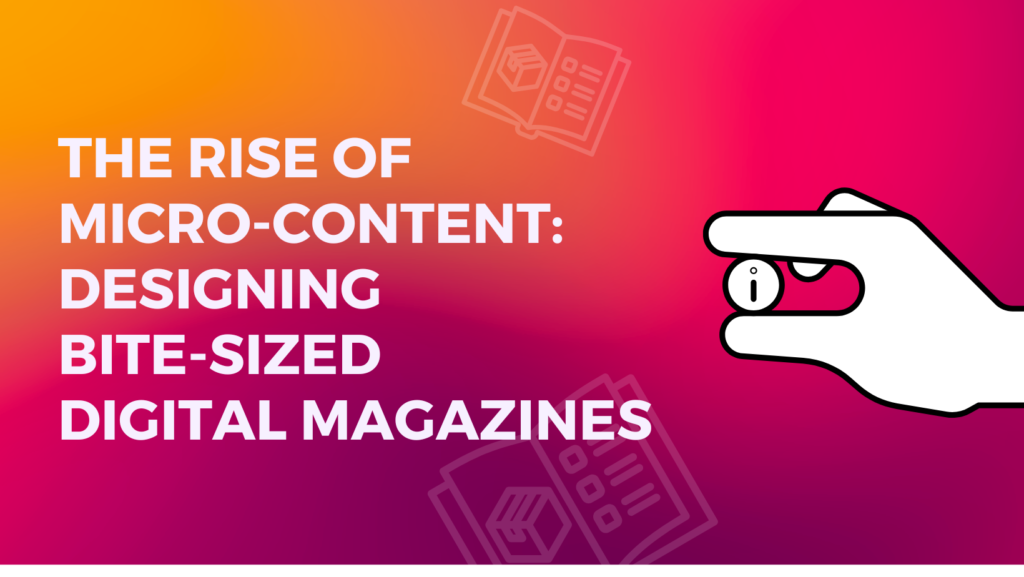
Attention spans are getting shorter, and readers are increasingly drawn to content that is quick, accessible, and easy to consume. Enter micro-content: short, focused pieces designed to be consumed quickly. As digital publishing evolves, bite-sized digital magazines are becoming an essential format for engaging audiences who are constantly on the go. This trend is reshaping how publishers create and deliver content, making it more efficient and engaging for today’s reader. Let’s explore the rise of micro-content and how you can design effective, bite-sized digital magazines.
What is Micro-Content?
Micro-content refers to small, easily digestible pieces of content that deliver value in a concise format. It can range from short articles and infographics to video snippets and interactive polls. The idea is to create content that fits into short periods of a reader’s day—whether that’s during a commute, lunch break, or while waiting in line. Bite-sized digital magazines leverage micro-content to deliver engaging stories, news, or tips in just a few minutes, making it ideal for today’s busy audiences.
Why Micro-Content Matters in Digital Publishing
Micro-content caters to the digital reader’s need for instant gratification. With so many competing sources of information and entertainment, offering compact, high-value content is an effective way to capture and retain attention. Here’s why micro-content is gaining traction:
- Short Attention Spans: Studies show that attention spans are shrinking, especially when consuming digital content. Micro-content is designed to fit these short bursts of attention, making it easier for readers to engage with your magazine quickly.
- Mobile-First Consumption: The majority of digital magazine readers access content via mobile devices. Micro-content, with its short and visual nature, fits perfectly within the mobile experience, ensuring that readers can consume content comfortably on smaller screens.
- Increased Engagement Opportunities: Micro-content is inherently shareable and interactive. Whether through quick quizzes, short videos, or swipeable galleries, bite-sized formats encourage interaction, increasing reader engagement and sharing across social platforms.
Designing Bite-Sized Digital Magazines: Key Strategies
To effectively create a micro-content digital magazine, it’s essential to design with purpose and clarity. Here are some strategies to help you craft engaging bite-sized magazines:
1. Prioritize Visual Storytelling
In micro-content, visuals are your best tool. Use striking imagery, infographics, and animations to tell your story quickly and effectively. Readers should be able to grasp the essence of your content at a glance. Consider using visual elements like illustrated tips, quick stat highlights, or visual progress bars to make content instantly appealing and informative.
2. Modular Layouts for Flexibility
Micro-content thrives on modular design—a structure where content is broken down into self-contained sections or modules. This approach allows readers to pick and choose the content they want to engage with, rather than committing to long articles. It also gives you flexibility to rearrange and update content easily, keeping the magazine fresh and relevant.
For example, a bite-sized digital magazine could feature a modular layout with short news snippets, visual how-tos, quick reviews, and brief video highlights—all organized in easily navigable sections. This setup ensures that readers can consume only what they’re interested in, making the experience more personalized.
3. Optimize for Mobile Readers
A mobile-first approach is crucial when designing micro-content magazines. Ensure that your magazine’s layout adapts seamlessly to various screen sizes, maintaining readability and visual appeal on mobile devices. Use touch-friendly elements, such as swipeable image galleries and tap-to-expand sections, to enhance the mobile user experience.
The key is to maintain simplicity—avoid overwhelming readers with too much information at once. By prioritizing content that is easy to navigate and consume on mobile, you can maximize engagement and accessibility for readers on the go.
4. Incorporate Interactive Features
Interactive elements like quizzes, polls, and instant feedback buttons are perfect for micro-content. They allow readers to engage with content quickly, turning a passive reading experience into an active one. Interactive features not only make the content more engaging but also provide valuable insights into reader preferences and behaviors.
5. Use Snackable Video Content
Videos remain one of the most engaging formats in digital content, and they are a perfect fit for micro-content magazines. Short videos (under 60 seconds) can effectively convey messages, demonstrate products, or provide quick tips. Videos are also highly shareable, making them a powerful tool for expanding your magazine’s reach beyond its immediate audience.
For instance, a travel digital magazine could feature short, captivating videos showcasing travel tips, hidden gems, or quick destination guides, all easily consumable within seconds.
6. Incorporate Bite-Sized, Interactive Infographics
Infographics are an excellent way to present information in a condensed, visual format. In a micro-content magazine, these can be designed to be interactive—allowing readers to click, swipe, or hover to reveal more information. This interactive engagement makes the content not only informative but also fun to explore.
Whether it’s a step-by-step guide on skincare routines or a quick breakdown of trending tech gadgets, infographics can convey complex information in a way that’s easy to understand and visually compelling.
7. Focus on Real-Time Updates
Micro-content magazines often serve as quick sources of information, so keeping content current and relevant is essential. Consider adding real-time updates like breaking news, social media feeds, or live event coverage. This creates a sense of urgency and timeliness, encouraging readers to check back frequently.
Integrating real-time content also builds credibility, as readers see the publication as a reliable source for up-to-date information. For instance, a business digital magazine might feature live stock market updates or curated tweets from industry experts, making the content both relevant and engaging.
As audiences continue to seek out quick, engaging, and easily accessible content, the rise of micro-content and bite-sized digital magazines is set to grow even further in 2024 and beyond. By leveraging visual storytelling, modular layouts, interactive elements, and mobile optimization, publishers can create captivating digital experiences that cater to the needs of modern readers. Embracing this trend not only keeps your publication relevant but also opens up new opportunities for engagement, ensuring your digital magazine remains at the forefront of digital publishing.







